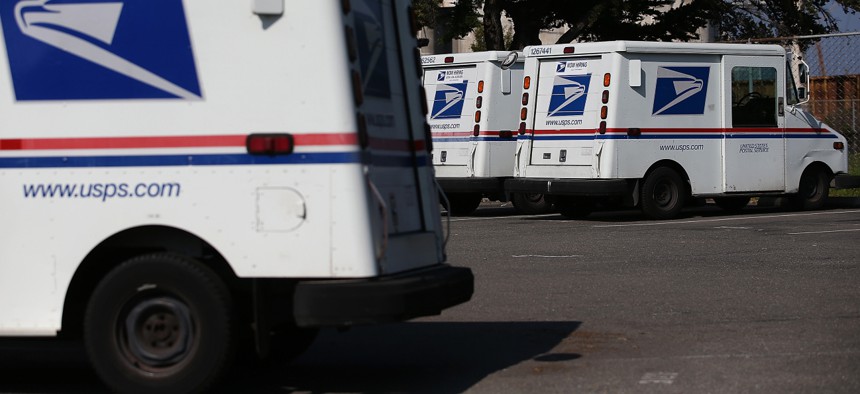
The Postal Service is in the midst of replacing 165,000 trucks and vans from its fleet. Justin Sullivan/Getty Images
After Providing $3B, Lawmakers Question Why USPS Isn’t Buying More EVs
The Postal Service has upped its original order of electric vehicles, but Democrats want to see far more progress after they provided the funds.
Lawmakers are ramping up pressure on the U.S. Postal Service to increase its use of electric vehicles after Congress provided the agency with $3 billion for expressly that purpose.
USPS has been slow to release its plans to spend that money and has yet to update its promised EV purchase rate since receiving the funds. The Postal Service is in the midst of replacing 165,000 trucks and vans from its fleet. It has so far ordered 50,000 vehicles through its multi-billion dollar contract with Oshkosh defense and said half of those would be electric. It announced it would buy an additional 35,000 EVs off the shelf,
“I am concerned that the Postal Service still appears to be many months away from finalizing a plan to use the $3 billion in new funding Congress appropriated for EVs,” said Rep. Carolyn Maloney, D-N.Y., who will chair the House Oversight and Reform Committee until she departs Congress next year. “That delay will set back the effort to electrify the postal fleet, and I urge the Postal Service to move faster to produce a clear plan for using the resources appropriated by Congress and build a fully electric postal fleet.”
Maloney sent a letter to Postmaster General Louis DeJoy in October asking for details on how USPS will spend the $3 billion it received as part of the Inflation Reduction Act, but postal management said it is still making those determinations. The congresswoman could soon have more influence over the makeup of the postal fleet, as she is lobbying for a spot on the agency’s board of governors. President Biden has yet to nominate anyone for the two slots that will open later this year.
Last week, 11 Democratic senators, led by Ed Markey, Mass., and Tom Carper, Del., sent a letter of their own to DeJoy and board Chairman Roman Martinez asking USPS to “dramatically increase” their fleet electrification rates from 40% to 95%.
“We urge USPS to use the $3 billion in new funding from the Inflation Reduction Act to further increase its vehicle electrification efforts and not merely spend the money on the 40% [battery electric vehicle] commitment it had already made and had the resources to achieve,” the senators said.
The USPS inspector general found earlier this year USPS can viably support about 99% of its routes every day using all electric vehicles. It subsequently announced it was investigating the Oshkosh contract and whether postal management has met its obligations for environmental reviews.
Kim Frum, a USPS spokeswoman, did not say when the Postal Service would update its plans for spending its new funds.
“The Postal Service commits to evaluate vehicle mix and purchase capability in shorter intervals as technology evolves and the organization’s financial and operational picture improve,” Frum said. “We remain committed to reducing our carbon footprint in many areas of our operations and expanding the use of EV’s in our fleet is a priority within the parameters mentioned.”
The Biden administration has publicly pushed USPS to conduct a new environmental impact study to justify its plan to buy primarily gas-powered vehicles, saying its original study was insufficient and rested upon faulty assumptions. After initially declining to do so and saying a new review was unnecessary, postal management in June said it would supplement its study and potentially expand the number of EVs it planned to buy. That announcement followed President Biden in April signing into law the first significant postal reform law in 15 years, which is expected to save a combined $107 billion for USPS by eliminating existing debt and taking future liabilities off of its books.
Postal management pointed to its plan to consolidate many of its processing facilities into mega-centers in justifying why more EVs make sense operationally. The revised network, part of Postmaster General Louis DeJoy’s 10-year break-even plan, will lead to fewer trips between facilities, more optimized routes and charging stations consolidated at fewer locations. USPS vowed to conduct additional impact studies before each round of vehicle purchases, saying it will carry out those evaluations frequently so it can quickly adapt to changes in technology, market conditions and its own operational strategy. It did not commit to buying more vehicles through its Oshkosh contract, saying instead that it will weigh tapping into it versus simply buying off-the-shelf options.
The new Next Generation Delivery Vehicles are expected to be on the road in late 2023. DeJoy previously said he was “not even thinking about” the makeup of future vehicle procurements, noting the original 50,000 order was not expected to be complete until 2027. Citing the “critical and immediate need” to speed up the replacement of its existing fleet, however, management is now looking to speed up that timeline with off-the-shelf vehicles.
USPS’ improved cash position is in part due to its higher-than-usual price increases DeJoy and the board have implemented under authority it gained in 2020. In October, postal management announced it was seeking to raise rates for regular, First-Class mail by 4.2% after surging them by 6.5% in July. This week, the Postal Regulatory Commission approved the increases, meaning they will take effect Jan. 22.







